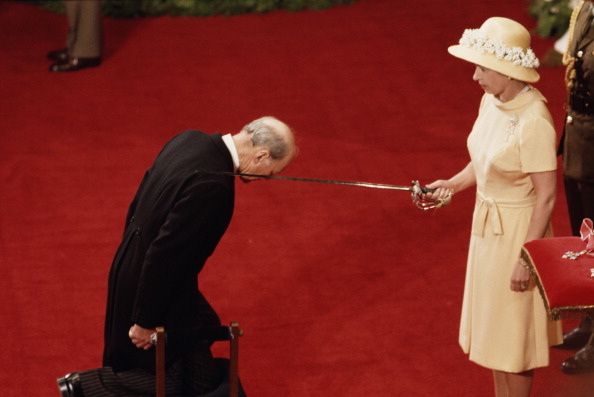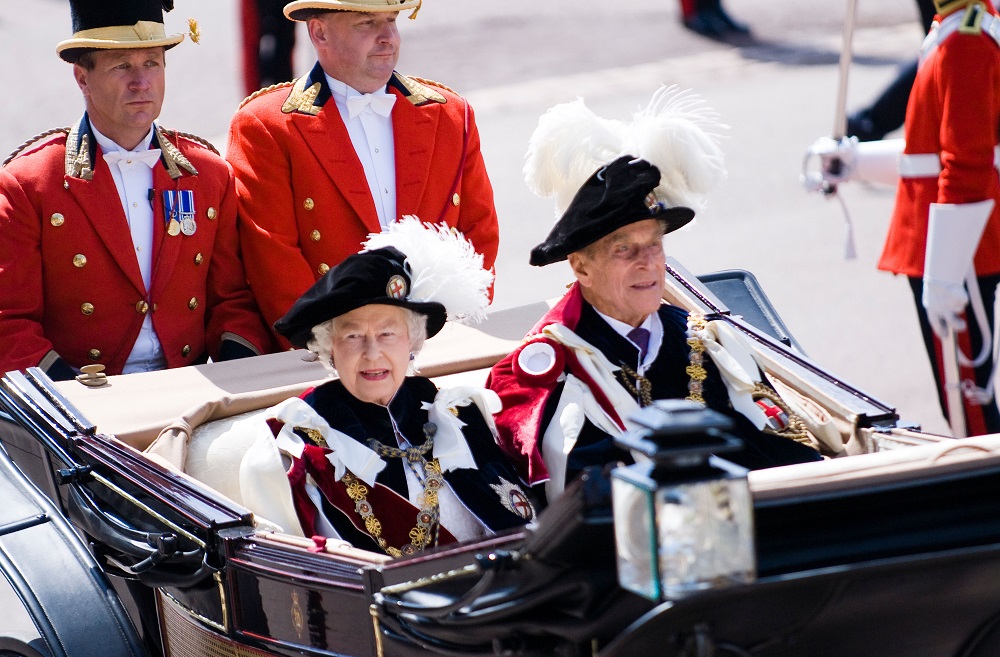The honours system during the reign of Queen Elizabeth II
Twice a year, British honour recipients are announced in The Gazette – at new year and on the monarch’s official birthday. Royal commentator and British honours expert, Richard Fitzwilliams looks at how the honours system evolved during the long reign of Elizabeth II.

During the Queen’s reign, the contribution of many thousands of people – some well-known and many lesser-known – were recognised in the biannual honours lists, published between May and June on the monarch’s official birthday, and at new year.
A look at Elizabeth II’s coronation honours of 1953 (Gazette issue 39863) is like a glimpse into the now long-vanished era of Empire. The military divisions of the orders in that list remind us of Britain’s battle for survival during World War 2, showing how many of those who contributed to victory were still being honoured.
Much has changed – in both British society and the honours system – since 1953. Changes to the honours system itself have come slowly but, over the last two decades, the huge social changes that have occurred during the Queen’s reign have been reflected in it.
Today, around 3,500 nominations from the public are considered each year, and each honours list contains the names of some 1,200 individuals whose contributions have been recognised.
Orders in the British honours system
The history of the various orders shows how the system is interlinked with Britain’s past, something that is easily overlooking in an age where comment can be reduced to a soundbite on social media. Each of the orders has its own story and is consequently much prized by recipients.
There are several honours in the gift of the monarch. The rest are recommended by the prime minister on the advice of the Honours and Appointments Secretariat of the Cabinet Office, which receives nominees from the Main Honours Committee, the Foreign and Commonwealth Office and the Ministry of Defence. It is one of the strengths of the system that most of the orders have grades. These encourage initiative and incentive in the same way that the five grades of the Legion d’honneur in France and their equivalents elsewhere do, but the United States, which have one level, do not.

At the pinnacle of the system is the highest order of chivalry, the Order of the Garter, which is outranked only by the Victoria Cross and George Cross. It was founded by Edward III – though its origins are disputed – and is limited to 24 members (in addition to the monarch and the Prince of Wales). There are annual Garter Day ceremonies for the investitures of new knights at the start of Royal Ascot Week, which was the Queen’s favourite week of the year. The Garter Day ceremony is like a medieval tableau come to life and is stunningly beautiful.
Most honours (some 90 per cent of those in the Queen’s later biannual honours lists) are in the Civil Division of the Order of the British Empire, which comprises:
- GBE – Knight Grand Cross or Dame Grand Cross of the Most Excellent Order of the British Empire
- KBE or DBE – Knight Commander or Dame Commander of the Most Excellent Order of the British Empire
- CBE – Commander of the Most Excellent Order of the British Empire
- OBE – Officer of the Most Excellent Order of the British Empire
- MBE – Member of the Most Excellent Order of the British Empire
The Order of the British Empire was created by George V during World War 1 to recognise the contribution of civilians during the war effort. Today, appointments are made to civilians, as well as members of the armed forces, on the recommendation of the prime minister. Affiliated to it is the British Empire Medal, awarded for meritorious local community service.

Investitures
The Queen regarded investitures as especially important as she knew how much they were valued by the recipients. They, and up to three members of their family, can attend an investiture ceremony and receive the honour from the monarch or a member of the royal family acting on her behalf.
We know, through the interviews they give, that this occasion can be one of the highlights of their lives. To be rewarded with an honour means that their efforts have been appreciated by others and that the nation has recognised this. This is probably the main reason why the percentage of those who refuse honours is estimated at only 2 per cent.
Around 30 investitures are held each year, with more than 60 recipients attending each one. The settings vary but are always splendid. The magnificent ballroom in Buckingham Palace, dating from Queen Victoria’s reign, hosts some 20 investitures annually, while the Waterloo Chamber at Windsor Castle, which commemorates the Duke of Wellington’s famous victory over Napoleon, also regularly hosts ceremonies. Investitures for Scottish recipients of honours are held in the historic Great Gallery at the Palace of Holyroodhouse in Edinburgh. In addition, the Queen (the most travelled member of the royal family ever) conducted many investitures when abroad on state or royal visits.
Before a ceremony takes place, the insignia are arranged and polished. Warrants of appointment for some of the honours will also have been sent to the reigning monarch or another member of the royal family for signing. When the monarch or the presiding member of the royal family enters an investiture, they are attended by the monarch’s Bodyguard of the Yeoman of the Guard. The National Anthem is played, and two Gurkha orderly officers accompany them, a tradition dating back to Queen Victoria. The decoration is placed on a cushion before it is handed to the presiding member of the royal family. The Lord Chamberlain then calls out the name of each recipient, who will have been given a special pin to which the honour is attached. The recipient has the chance to exchange a few words with the presiding member of the royal family after receiving their honour. During her reign, Elizabeth II dubbed new knights with the sword that once belonged to her father, King George VI.
Following ceremonies at Buckingham Palace, recipients and their families and friends gather in the quadrangle of the palace, where photographs can be taken. Well-known recipients are often interviewed and photographed by the press.

Honours for foreign citizens
The Queen’s devotion to the Commonwealth was legendary and citizens of all 15 Commonwealth realms receive honours through the British honours system. Many, including Antigua and Barbuda, the Bahamas, Belize, Grenada, Papua New Guinea, St Kitts and Nevis, Saint Lucia, the Solomon Islands, and Tuvalu, continue to recommend appointments to the Order of the British Empire.
Honorary awards are also bestowed on prominent foreign citizens who are recommended by the government as having made a significant contribution to relations between the United Kingdom and their country of origin. The supremely high regard in which the Queen was held internationally undoubtedly added a very special cachet to these awards. Indeed, partly because of the high profile of the monarchy, the appeal of British honours to foreign recipients could fairly be said to surpass those of any other country.
There can be imitations, however, such as the CBE of the former Ugandan dictator, Idi Amin. He claimed it stood for Conqueror of the British Empire, and promptly awarded it to himself.
Refusing a British honour
The Victorian statesman Benjamin Disraeli, when elevated to the peerage (Gazette issue 24355), once compared receiving his honour to being ‘in the Elysian fields’. Yet obviously there are those who take a different view and decline an honour.
During the Queen’s reign, there was always a fascination for the reason why the tiny number who declined honours did so. A secret list of those who have refused honours, first leaked to The Sunday Times in 2003, was released under the Freedom of Information Act in 2012. It included such notables as the film director Ken Loach, the artists Lucian Freud and David Hockney, the actor Albert Finney, and the singer David Bowie. The artist L.S. Lowry declined four different honours on five separate occasions, which is currently a record.
However, the reasons behind rejecting an honour are often more complex than they might at first appear. Some might turn down an honour at one level but accept a higher one, such as the actor and director Kenneth Branagh, who declined a CBE but accepted a knighthood (Gazette issue 60593), and the actor Helen Mirren, who declined a CBE but accepted a damehood (Gazette issue 56963). In contrast, the actor Vanessa Redgrave declined a DBE in 1999 but accepted a CBE more than 40 years earlier (Gazette issue 44326). She also later accepted a DBE in the 2022 New Year Honours (Gazette issue 63571). The film director Alfred Hitchcock declined a CBE but accepted a knighthood just before his death (Gazette issue 48041), while the actor Paul Scofield declined a knighthood three times before accepting a Companion of Honour (CH) award in 2000 (Gazette issue 56070).
The problem in some cases is not knowing when death will occur. The writer Evelyn Waugh declined a CBE believing he should get a knighthood and unwisely committed these thoughts to paper. The novelist Roald Dahl declined an OBE, reportedly for the same reason. Both died unhonoured.
We rarely hear the reason for a person declining an honour, although the writer Benjamin Zephaniah cited exploitation in the era of Empire, as have some others. Honours, however, are rarely renounced. John Lennon’s returning of his MBE (Gazette issue 43667) in protest against the government’s foreign policy in 1969 was probably the most publicised.

Honours for sport and popular culture
In more recent years there has been a seismic change in the way sporting honours are awarded. The likes of Fred Perry, who won three consecutive men’s Wimbledon singles from 1934 to 1936, were never honoured. In the early years of the Queen’s reign, however, sporting honours included knighthoods for cricketers Sir Len Hutton (Gazette issue 40787) and Sir Jack Hobbs (Gazette issue 39863), and a CBE in 1955 for Roger Bannister after he ran a mile in under four minutes (Gazette issue 40497). Bannister would also be knighted two decades later (Gazette issue 46444).
In 1966, when England won the FIFA World Cup, only manager Sir Alf Ramsey, with a knighthood (Gazette issue 44210), and captain Bobby Moore, with an OBE (Gazette issue 44210), were honoured. The awards of honours to whole teams, when England’s Rugby World Cup team was victorious in 2003 (Gazette issue 57155) and when England won the Ashes in 2005 (Gazette issue 57855), showed a very different approach.
Great Britain and Northern Ireland’s success at the Sydney Olympics in 2000 set a trend for awarding the those who had won a gold medal. However, as our athletes have won so many medals, especially gold medals, in the subsequent Olympic and Paralympic Games, there was simply no way any system, even one with grades, could adequately reward them.
When it comes to the arts and entertainment, there is considerable public interest in who is chosen for honours as, unlike most other fields, many names will be recognised. During the reign of Elizabeth II, singers tended to be offered knighthoods when they were in their fifties or older. Sir Elton John (Gazette issue 54993), Dame Vera Lynn (Gazette issue 46593), Sir Paul McCartney (Gazette issue 54625), Dame Shirley Bassey (Gazette issue 55710) and Sir Mick Jagger (Gazette issue 56595) are examples of this. In the world of acting, the likes of Sir Ian McKellen (Gazette issue 52382) and Dame Judi Dench (Gazette issue 51171) were also honoured, but perhaps surprisingly, Lord Olivier still remains the first and only life peer created predominantly for his acting abilities (Gazette issue 45117).

Controversy surrounding the honours system
The Honours Forfeiture Committee has always had the power to remove honours if the behaviour of a recipient would ‘bring the honours system into disrepute’. During the Queen’s reign, several honours have been removed from recipients; twenty were removed between 2012 and 2014, for example.
Some recipients were convicted and imprisoned, as was the case for the jockey Lester Piggott (Gazette issue 46444) and the economist Vicky Pryce (Gazette issue 59090). The case of Fred Goodwin, the former chief executive officer of the Royal Bank of Scotland, was also extremely high profile. Stripped of his knighthood in 2012 (Gazette issue 57315), the Cabinet Office were quoted as saying that ‘the scale and severity of the impact of his actions … made this an exceptional case’. However, honours still cannot be removed from, nor conferred on, anyone posthumously. The likes of wartime computer scientist and genius Alan Turing therefore cannot be honoured.
Prime ministers do, of course, have the right to bestow honours on people of their choosing in the Resignation Honours List. Written on the lavender-coloured notepaper of his private secretary, Lady Falkender, Harold Wilson’s so-called ‘Lavender List’ of 1976 (Gazette issue 46916) became notorious after including some inappropriate figures. In a glorious mix-up, which seemed symbolic of the whole affair, the list included Harry Corbett, the creator of Sooty the glove puppet, when the OBE he received was intended for Harry H. Corbett, the Labour-supporting actor. The recent Resignation Honours Lists of Prime Ministers David Cameron (Gazette issue 61678) and Theresa May (Gazette issue 62807) also attracted criticism.
It has always been, and remains, essential that the system of honours with which a nation rewards those who ‘have done the state some service’ has broad support among the public and is as fair and transparent as possible. Intense debate continues over how and why nominees are chosen for honours. There are omissions and inconsistencies in all fields where many decisions are, of necessity, subjective and where inevitably the allocation of honours must be divided between the ten committees who assess them.
Any criticisms of the honours system should also be seen in context of having to choose each year some 2,500 achievers in every field of human activity who help to make the United Kingdom what it is today; a more caring, fairer and more just society.

Bringing the honours system into the 21st century
The system of honours dates from medieval times when knighthoods were linked to military service. When monarchs needed assistance in war or to keep the peace, they often bestowed honours on the nobility. As the British political system evolved, prime ministerial influence became significant and, until the 19th century, honours were exclusively bestowed on the aristocracy and senior military figures. In the 20th century, the system very gradually expanded to include successful members of the middle classes and, subsequently, to all fields of human endeavour.
However, the honours system changed little until 1993, when Prime Minister John Major’s reforms encouraged the public to nominate deserving figures by writing to the Honours and Appointments Secretariat of the Cabinet Office, together with sponsors. Now anybody in the United Kingdom can make a recommendation, by post, email or online, for a British national to receive an honour, and some 3,500 nominations are considered from the public every year.
While the honours systems stayed consistent in its grades and orders during Elizabeth II’s reign, in 1965 The Queen’s Award to Industry (most recently called The Queen’s Awards for Enterprise) was established. Deriving from the Queen’s strong commitment to promote British business and entrepreneurship, the award – the most significant of its type – recognises special achievement in the areas of international trade, innovation, sustainable development, and the promotion of opportunity through social mobility.
Her Majesty also announced The Queen’s Award for Voluntary Service in 2002 during her Golden Jubilee address to both Houses of Parliament. Awarded each year on the anniversary of her coronation and considered to be equivalent to an MBE, it recognises the achievement of groups of two or more people who have provided voluntary service to the community.
But more significant changes to the honours system were to come. In response to pressure following The Sunday Times leaks in 2003, the government commissioned Sir Hayden Phillips to conduct a review of the honours system. The comprehensive Phillips Report, released in 2005, drew attention to the urgent need to recognise more women, especially at the higher levels, to nominate more minorities and to further reduce the number of awards to state servants. This led to some important and welcome changes. All the names on the honours committees were to be made public, and all but the Main Honours Committee (which is chaired by the cabinet secretary and consists of the chairs of the various honours committees plus top civil servants) were to have independent heads who were not civil servants. Neither would the majority of members of each committee be from the civil service.

The eleven committees currently responsible for choosing honours are:
- Arts and Media
- Community and Voluntary Service
- The Economy
- Education
- Health
- Parliamentary and Political Service
- Public Service
- Science and Technology
- Sport
- State
- Diversity and Inclusion Group
The names of the experts who advise them, however, are kept confidential to avoid their being lobbied. The committees’ recommendations go to the prime minister and then to the monarch. All nominees are checked by various government departments to ensure that they are suitable for an honour, and the system itself is reviewed by the government every three to five years.
The Diversity and Inclusion Group that was set up in 2014 supports women, those from a minority background, people with disabilities, and those who identify as LGBTQ+. It has targets for total gender equality at senior levels and for better representation of black and minority ethnic groups. The system has developed positively; however, there is still more to do, including improvements to regional diversity, as London and the south-east tend to be better represented than other parts of the country.
The future of the British honours system
The Gazette has published biannual honours lists every year during the reign of Elizabeth II, and the Queen herself attended hundreds of investitures, bestowing honours upon the individuals who were recognised for their contribution to society.
During the latter part of her reign, the honours system adjusted at a much faster pace than at any time in its long history. It now incorporates the ancient orders with their grades and romantic history while endeavouring to reward those in our society, from all backgrounds, who have achieved excellence in their work and who have helped others.
The system itself has gradually evolved since Elizabeth II’s coronation all those years ago, now placing an emphasis on philanthropy – the theme of so many of the Queen’s Christmas messages – and it will continue to evolve in the future as it strives to be more diverse and better reflect our contemporary society.

About the author
Richard Fitzwilliams is a London-based journalist who was born in Cape Town and educated at the University of Cape Town. He was assistant editor on Africa South of the Sahara 1972–75 and subsequently became editor of The International Who’s Who from 1975 to 2001. This volume was considered to be the standard biographical reference work of its type,containing the biographies of some 20,000 of the world’s most prominent men and women.
Since then he has been a royal commentator, film critic and public relations consultant. He has given more than 1,000 interviews on television and radio, both nationally and internationally, and has lectured and written on his specialist topics, one of which is the honours system. He promotes the annual exhibition of the Royal Society of Portrait Painters at the Mall Galleries. He is also the weekly film critic for Talk Radio Europe and Siren Radio and commentated on the major film awards.
Website: www.richardfitzwilliams.com
Twitter: @RFitzwilliams
Instagram: @richardfitzwilliams
Wikipedia: www.wikipedia.org/wiki/Richard_Fitzwilliams
Images (in order of appearance):
Serge Lemoine/Getty Images
Karolina Webb / Alamy Stock Photo
Cofiant Images / Alamy Stock Photo
Trinity Mirror / Mirrorpix / Alamy Stock Photo
Trinity Mirror / Mirrorpix / Alamy Stock Photo
Trinity Mirror / Mirrorpix / Alamy Stock Photo
Matt Limb OBE / Alamy Stock Photo
Yui Mok - WPA Pool/Getty Images
